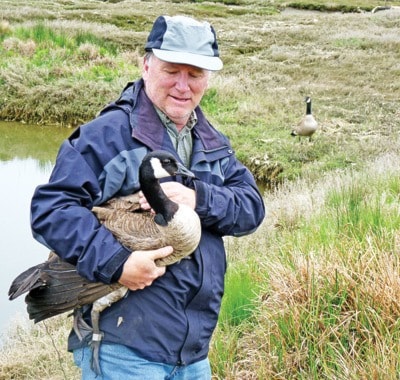Resident Canada geese are a familiar sight in these parts year round and their presence has several environmental groups combining their efforts to control the goose population before the birds completely wipe out important habitat.
The Oceanside group, Guardians of Mid-Island Estuaries Society (GMIES) made a plea to directors of the Regional District of Nanaimo (RDN) on January 17 for a $10,000 grant that will go towards controlling the invasive bird population and repairing the damage they have done to the Englishman River and Little Qualicum River Estuaries. The funding request for the GMIES 2012-2015 rehabilitation project was approved by directors but still needs formal approval from the regional board before the group gets the money.
On estuaries all along the east coast of Vancouver Island, particularly where hunting opportunities are limited, Canada geese are causing substantive changes to marsh habitats, according to these reports.
As the geese progressively remove the above and below-ground vegetation — mainly Lyngbye’s sedge — the rich, organic substrates erode and wash away. As a result, the primary productivity of the estuaries — creating critical habitat for salmon, wintering and migratory waterbirds, and other species groups — is also eroded.
The primary goal of the GMIES project is to re‐vegetate the denuded areas with native species that provide high quality habitat for rearing juvenile salmonids and wintering waterfowl. It’s hoped that the project will undo some of the damage done to the marsh structure and function resulting from grazing and grubbing by the ever‐increasing populations of non‐migratory Canada geese (CAGO).
Tim Clermont, vice-president of the Guardians of Mid Island Estuaries Society said for the Little Qualicum and Englishman river estuaries, this process may have already reached a tipping point, beyond which the estuaries lose the ability to perform valuable ecological services. In both estuaries, ecological communities containing Lyngbye’s sedge have been reduced to a fraction of their former extent.
“We have all been impacted by the rise of resident Canada Geese over the past two decades,” Clermont said. “As conservation groups have invested millions to protect and restore estuaries, resident Canada Geese have done more damage than historical log storage and handling to these sensitive areas. The bottom line is we need to work together to reduce the resident goose populations that nest in our estuaries.”
For some biologists, Canada geese that stay in the area year-round are no different than European starlings, American bullfrogs or Scotch broom which are considered invasive.
The geese were introduced to the area for hunting and wildlife viewing opportunities several decades ago, and their populations have been increasing ever since, causing all kinds of environmental problems.
Some measures taken to reduce the resident CAGO population includes egg addling, but the egg sterilization program is currently limited to the Englishman and Little Qualicum river estuaries. Research technicians with GMIES are calling for an expansion of the areas targeted for addling to include the Nanoose estuary as well as other areas along the Englishman River.
Culling the birds has been proposed but whether such an extreme measure will be considered isn’t clear. According to the Canadian Wildlife Service, culling has never been done in this region for any bird species, and there is no legal mechanism for a cull through the Migratory Birds Convention Act. In at least one other jurisdiction in Canada, birds have been culled to protect ecological integrity and Species at Risk in a national park.
However the species was not listed in the Migratory Birds Convention Act.
Canada Goose population management strategies have included egg sterilization programs, moult round-up and relocations, and modifications to hunting regulations. The latter option has its own set of problems because there are migratory Canada Geese on mid-Vancouver Island as well, including the provincially red-listed Dusky Canada Goose so it is important that management strategies for nuisance birds not adversely affect rare migrants.
Doug Janz, an expert on the subject and a director with GMIES, said hunter harvest continues to decline due to increasing urban growth and associated safety concerns. Yet, he stated increasing hunting opportunities could be part of a solution to the problem.
“Providing larger bag limits and manipulating the season openings and lengths is feasible, but the real challenge is to direct hunting activities to areas that both attract geese and are suitable for the safe discharge of shotguns,” he stated, and added, “As there are numerous farms in the Parksville-Qualicum area that attract geese and cause depredation damage, our efforts will focus on these areas by connecting responsible hunters with willing landowners.”
Clermont said education and outreach initiatives are integral to the development of community support for the rehabilitation project. Presentations have been previously made to a number of different conservation groups and government organizations including the Nanoose Naturalists, The City of Parksville and the RDN and outreach to local farmers and businesses has been carried out and there will be further presentations to local fish and game clubs, conservation groups and businesses.
Clermont said they are delighted that local governments are taking a leadership role in assisting their group to provide the science and rationale that is needed to increase efforts to reduce the resident goose numbers to a manageable level.
